France
Paris
Switch to your local agency
Retour au menu
Welcome to the third edition of Useful Design Trends, our annual exploration of the movements shaping the future of design in various sectors and global markets.
Trends offer a unique vantage point from which to view the future, not as a distant horizon, but as a series of actionable opportunities. This approach is rooted in our belief that design is a problem-solving tool, a means of meeting the challenges of our time with creativity and purpose.
Covering more than 40 sectors and 90 case studies, the global and multi-category perspective ensures a comprehensive and diverse view of the design landscape. Each trend we explore in this Useful Design Trends 2024 is a window into how design can inspire utility, whether in the way we interact with our environment, empower individuals, improve well-being, promote social growth or democratize access.
There are 15 trends that promise longevity and sustainability, transcending the ephemerality that usually characterizes the world of brands. Our focus is on trends that last, that evolve and that continue to resonate year after year. We collect and select movements that not only signal change, but drive it.
For us, design goes beyond aesthetic appeal, acting as an accelerator of meaningful change. This belief is summed up in our Useful Design Model, which is anchored in three levels of impact: individual, collective and global. These levels form the basis of our approach and are an integral part of the reporting structure.
It is structured around five essential pillars: Environment, Empowerment, Well-being, Society and Access. Each pillar represents a fundamental aspect of our world, highlighting the significant role of design in creating a better future. Through these pillars, we aim to show how design transcends traditional boundaries, acting as a powerful agent of transformation and progress.
Here is a summary of the pillars and their trends in this Useful Design Trends 2024:
As we face the growing challenges of climate change, evidenced by record-breaking weather disasters in 2023, the urgency for sustainable initiatives has never been clearer. This pillar explores how design can revolutionize our production and consumption processes, advocating a shift towards sustainability that resonates at an industrial level.
1. The Basics Reimagined
Reinventing raw materials and everyday essentials is a must.
Opportunity: Mind the Senses
When selecting new materials, consider the sensory impact of products. The tactile, visual, and even auditory qualities of materials can significantly influence the consumer experience. It’s all about creating a deeper, more memorable connection with your audience.
2. Extended Lifespan
Reusing product life cycles, reducing waste and aligning with consumers’ sustainable demands.
Opportunity: Sustainability as a service
Offering subscription-based models in which maintenance, upgrades and end-of-life product management are included can be a game changer. This type of model ensures that products are kept in optimum condition for longer and that, when they reach the end of their useful life, they are disposed of responsibly.
3. Ancestral Future
Combining ancient wisdom with modern environmental solutions can bring advances and positive results for everyone.
Opportunity: Sustainable supply chains with a story
Invest in supply chains that not only prioritize sustainability, but also have a narrative. Source materials and ingredients from indigenous communities in a way that supports local economies and ecosystems. This approach ensures a sustainable and ethical supply chain and also gives products a compelling story that resonates with conscious consumers.
Centered on Identity and Inclusion, this pillar addresses the need for design to empower people, especially Generation Z, to express their unique identities. It highlights the importance of universal design solutions that embrace diversity and promote self-confidence and self-expression.
4. Universal Standard
Addressing solutions through inclusive design, moving from niche adaptations to universal accessibility in conventional products and services.
Opportunity: Empathetic AI assistance
Leveraging AI to develop virtual assistants that adapt intuitively to the diverse needs of users, offering personalized and inclusive support for brand interaction and purchase journeys.
5. Out of the box
By rejecting traditional norms and aesthetics, Generation Z embraces chaos, imperfection and originality.
Opportunity: Encouraging creativity
When navigating these transformative times, brands and individuals should not shy away from the strange, but rather play and experiment, allowing their audience to step outside their comfort zone which will take them to unexpected places. In doing so, they can reimagine what the norm is.
6. Death of Gender
Moving away from binary gender norms, brands are adopting diverse and non-binary approaches to product design and marketing.
Opportunity: Expanding unisex products
Promote inclusion by expanding unisex product lines, ensuring that marketing and design approaches are actively breaking down gender norms and adopting universally appealing design principles.
This pillar takes a broad approach to improving quality of life, emphasizing physical, mental and emotional health. It explores how design can break taboos and create environments where individuals thrive, not just survive.
7. Menopower
Breaking the cycle of silence around the menopause is a significant transformation in the market, reflecting changing attitudes towards ageing and female empowerment in a growing Silver Economy.
Opportunity: Attention to language
Brands can go beyond terms like “anti-aging” by using positive and empowering language for products and campaigns about menopause and the beauty of aging gracefully.
8. Sex Education
Embracing sex positivity as a central pillar of holistic well-being, especially among younger generations.
Opportunity: Pop-up wellness experiences
Establishing spaces focused on sexual wellness that offer training, workshops and a portfolio of brands that guarantee a welcoming and stigma-free atmosphere.
9. The Good Drugs
The narrative around psychotropic substances, from contempt to appreciation, is evolving, reflecting a change in society’s perception, in line with holistic wellness trends.
Opportunity: Positive impact portfolio
Through strategic portfolio design, brands can develop a range of products that meet the different needs and preferences of consumers, from everyday wellness to more specific therapeutic solutions, maximizing positive impact.
Focuses on collective and shared growth, emphasizing the responsibility of organizations to contribute positively to their communities. In the wake of the pandemic and ongoing cultural changes, this section examines how design can facilitate community growth and shared value.
10. AI Powered Creativity
New possibilities and ethical challenges arise as AI reshapes creativity.
Opportunity: AI for social good
Harnessing AI to address global challenges and promote sustainable development offers immense potential. Whether monitoring environmental issues, promoting fairness in lending or advancing the UN SDGs, there is an opportunity for organizations to use AI as a tool for positive change.
11. Wiser Choices
Influencing behavior through design, emphasizing authenticity and leading by example.
Opportunity: Advice on moderate consumption
Brands must recognize their influence on consumer habits and commit to promoting moderation. This demonstrates corporate responsibility and is a key strategy for building trust and demonstrating genuine care for consumer well-being and environmental impact.
12. Better Together
Rising communities offer connection and support against digital isolation, with brands promoting spaces for connection and shared experiences.
Opportunity: Empower marginalized communities
Address economic disparities and promote cultural inclusion by providing tools and resources for the economic empowerment of underrepresented communities. This not only equips specific communities with the means to increase their wealth, but also ensures that their stories and perspectives are heard and valued in mainstream media.
The last pillar, Access, envisions a future in which resources are universally accessible, advocating the democratization of resources. It highlights the role of design in ensuring that progress and benefits are shared inclusively, contributing to the collective good.
13. Play it Smart
Consumers and brands are adapting to the rising cost of living, focusing on smart spending and economical, environmentally conscious solutions.
Opportunity: Transparent pricing
Empower consumers by developing an interactive platform that visually breaks down the costs of products. This platform could graphically represent how much is spent on raw materials, manufacturing, marketing and distribution, employing infographics and intuitive UI/UX.
14. Micro Mobility War
Cities around the world are turning to ecological micro mobility, with alternative methods of travel, changing the urban landscape.
Opportunity: Mobility partnerships
Brands from different sectors, from technology to fashion, can form partnerships with micromobility solutions. For example, a technology brand could collaborate with city bicycle programs to create smart helmets equipped with GPS and safety features. Or a clothing brand could create specific outfits for scooter users, with elements of safety, comfort and style.
15. Web3 to the People
Web3 is reformulating brand involvement with transparency, ethics and decentralized control.
Opportunity: Transparent supply chain solutions
Using blockchain to make supply chains more transparent and ethical. This can be an important selling point for eco-conscious consumers who value sustainability and ethical practices. Brands can demonstrate their commitment to these values by providing customers with a transparent view of the product journey, from production to delivery.
If this report has inspired you with new ideas, get in touch so that we can work together to make them happen!
Two years ago, CBA B+G embarked on a transformative journey by adopting a remote working model. This change was not only a response to global circumstances, but also a step towards innovation and adaptation to the new paradigms of the corporate world. The transition to remote working brought with it the need to adapt to digital processes, embracing the concept of flexible working. Today, we revisit the experience to understand how we have navigated these digital waters and what lessons have been learned along the way.
Our reflection is inspired by the conversation we had with Fernanda Mourão, Architect of the Future of Work, our guest at Café+ in November 2023 to talk about the topic. Fernanda is an expert on the subject and provided insights and good observations on the remote, hybrid and face-to-face models in the search for greater productivity and quality of life.
1. Space has become a working tool: Work is no longer a place but an activity. Spaces are now meeting places and the company culture is embodied in these environments.
2. Onboarding requires a lot of attention: Because it is relatively new, the flexible or hybrid work model requires a more careful integration and onboarding process, especially for newcomers and junior employees.
3. Adaptation and adjustment of perspective: The mechanisms for managing remote work have evolved rapidly, as has our adaptation to them. Natalia Azevedo, Senior Designer at CBA B+G, makes this point: “One thing we hear a lot is ‘in person we could get up and go to the colleague’s desk to talk’, as something that some people miss a lot. However, reading about the subject, there is a counterpoint from people who, when they were in the office, thought this was a terrible thing… I find this change in perspective very interesting, it shows how much we are biased by the ‘ideal of extroversion’ and we don’t even realize it.”
4. Self-management is key: Flexible working requires more robust planning and self-management skills, without relinquishing responsibility for the company. This can be a challenge for some managers. A good example is Spotify, which offers remote working strategies and options, with an emphasis on employer branding.
5. Romanticization vs. Reality: Recognize that not everyone is suited to being a “digital nomad” and that remote work is not a perfect, unanimous world ready to be inhabited. It has to be built – and in a collaborative way.
“One thing we hear a lot is ‘in person we could get up and go to the colleague's desk to talk’, as something that some people miss a lot. However, reading about the subject, there is a counterpoint from people who, when they were in the office, thought this was a terrible thing... I find this change in perspective very interesting, it shows how much we are biased by the ‘ideal of extroversion’ and we don't even realize it.”
Natalia Azevedo, Senior Designer at CBA B+G
6. Small talk has its value: It’s very important to create rituals that promote interactions not strictly related to work, adapting the dynamics of “small talk” to the online environment. We know that it’s not possible to reproduce the face-to-face experience in the digital world, but there are mechanisms to escape the distance and impersonality imposed by physical absence.
7. Quality of life and sustainability: The remote model offers a better individual quality of life and allows the inclusion of employees from different parts of the world. For Mateus Potumati, Verbal Designer at CBA B+G, “the exclusively remote model, as well as avoiding wasted time and increased stress, is much more sustainable. A company that can adopt it is making a huge contribution to reducing its carbon footprint. This, in my opinion, should even be encouraged by governments.”
8. The end of physical borders: An undeniable benefit of the remote model is the possibility of working with people from different corners of Brazil – and the world. This is not only beneficial for the work itself: it means a huge gain in diversity, inclusion and cultural breadth.
9.Mobility and new dynamics in the city: Supported by technology, the dynamics of everyday life have taken on new aspects, generating an impact on the environment – transportation, demographics and sustainability are being rethought.
10. New responsibilities for leaders and subordinates: The relationship with work has taken on new contours in terms of well-being, mental health and geographical freedom, as well as demanding greater self-knowledge from those who lead and are led. Everyone wins.
While CBA B+G positions itself as a “laboratory” company with a 100% remote working model, we recognize the advantages and disadvantages and are constantly learning. “Adopting the remote working model has imposed new challenges on us, such as reviewing results, metrics and behaviors. But I’m sure that this change contributes and will contribute to the long-term success of our organization,” comments Luís Bartolomei, CEO of CBA B+G.
The experience so far suggests that, despite the nostalgia for the office and the unique challenges of the remote model, there is more to be gained from deepening and improving this flexible format, especially in the context of large cities with their difficulties in getting around. We will continue to explore and discuss this topic, always open to learning and adapting to better meet the needs of our team and clients.
Design is a global language that connects like-minded people, and its role is to establish a meaningful dialogue between brands, cultures, products, and services. Brand experience is the lasting impression customers have of your brand, it’s when brands come to life. This experience includes thoughts, feelings and reactions that go beyond product purchase, and present the brand in a different way.
How can design help building a stronger and more consistent brand experience? To broaden the experience that a brand can offer, and to inspire you with design solutions for consumer goods, we have analyzed a couple of references and brought you some insights and examples:
Design is not just about visual elements, but also about creating a multisensory experience for customers. This can include using sound, touch, and even smell to create a more immersive brand experience.
Explore the brand assets all the way, inviting the audience to see the world through the brand’s unique perspective. Think of your product shape as a portal to a large ecosystem… Ask yourself questions such as ‘Is there any singular characteristics of my brand I should explore?’ or ‘If my brand dropped the logo or wordmark, would people still recognize it?’
The 5 senses open a gate of multi sensorial experience that creates a powerful emotional bond that people will never forget – and they will never see your brand the same way again.
Maggi sensorial culinary guide for the disabled
Cooking Blindly is a 130-page sensory guide that aims to stimulate the five senses, designed for people with different levels of visual impairment.
Packaging is not just a functional element, but also a canvas for storytelling and brand expression. Brands can use packaging to convey their brand story, values, and personality, creating a deeper connection with customers. Never underestimate your packaging potential to communicate uniqueness and ultimately engage with your audience.
Infuse storytelling on pack. Dare to use the packaging as a canvas to tell customers your campaign or your brand story. And never underestimate the back panel or the inside wrapper to express the brand’s point of view.
The pack can be the starting point to spark conversations and to stimulate everyone to express positivity, creating content and powerful social campaigns.
Coca-Cola Alphabet
Coca-Cola brings the letters of the alphabet on their cans and PET bottles for consumers to write messages and share them with the world.
an increasingly important factor in brand experience, as customers are looking for brands that are environmentally and socially responsible. Brands can use sustainable packaging materials, design for recyclability, and communicate their sustainability initiatives. Innovative, yet simple design solutions to become 100% eco-friendly and revolutionize the industry.
Global brands are embracing strong commitments with sustainability and showing them to the world with powerful aesthetic retail experiences and brand environment, using innovative design and powerful storytelling.
Get your customers to engage with your recycling and sustainable programs through rewarding schemes and hassle-free experiences that make it easy for them to participate.
Colgate Natural Extracts
First in Latin America with a recyclable tube
The digital world offers endless possibilities to create desirability, with one-of-kind digital collectibles and hybrid experiences that add an interactive layer in the traditional store format. By bringing the digital to the physical, we can create unique and memorable experiences.
You can create unique digital collections of your products that can help increase the value of your brand, making it more iconic and desirable.
Retailers are bringing the metaverse into the physical world. Others are using metaverse, to reinforce the unrivalled value of IRL experiences.
Nescafé Red Mug
We put a smile on Nescafé coffee lovers face on a physical to digital activation.
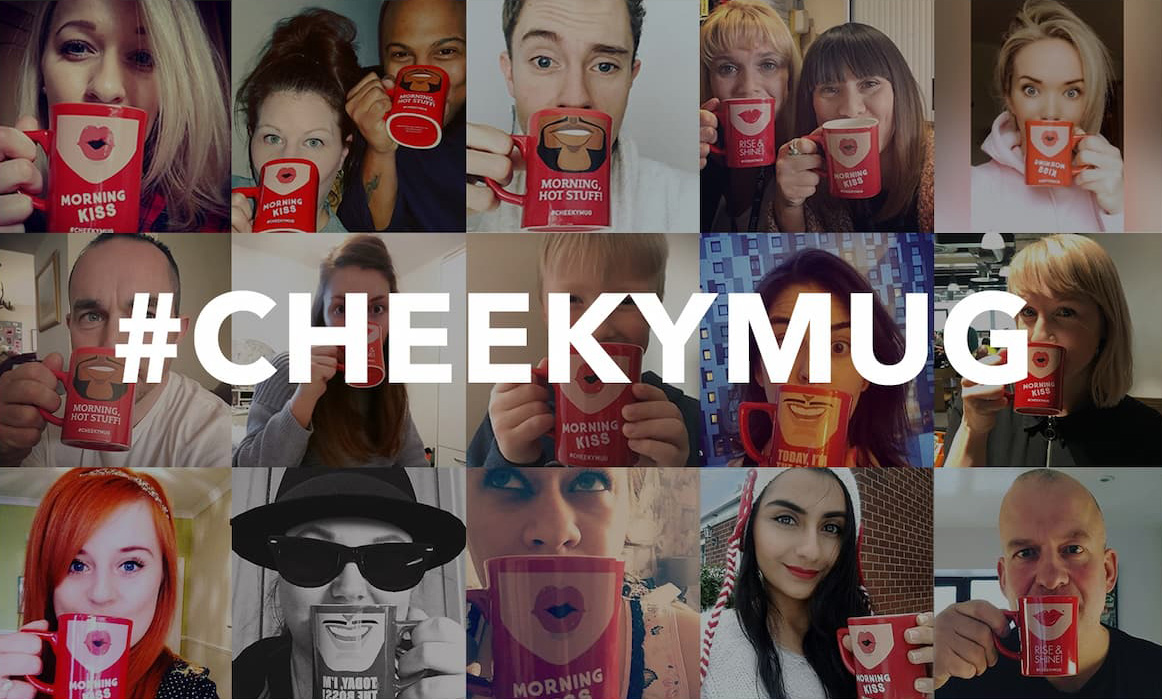
it is a powerful tool for amplifying brand experience. It allows brands to connect with customers in real-time and create a sense of community. Brands can use social media to share user-generated content, respond to customer feedback, and create engaging campaigns that encourage customers to share their experiences.
Netflix social media
A language close to users, winning people’s hearts.

Every aspect of a brand – verbal or visual – should work together to create a cohesive and memorable experience. From graphic to business design, we believe that design foremosts a way of thinking that uses specific methodologies to solve problems based on consumer experience. We work beyond the surface of our clients’ businesses, fully meeting their needs through projects that include branding consultancy for FMCG, service design, marketing, and business modeling.
If you are interested to explore the experience potential of your brand, do not hesitate to contact us.
“Meeting the needs of present generations without compromising the ability of future generations to meet their own ones.” – United Nations about food sustainability.
With sustainability becoming increasingly urgent in productive spheres, the agri-food industry stands at the forefront as one of the most concerned industries with this concept. Between fighting against waste and advocating for low ecological footprint consumption, sustainable food lies at the heart of tomorrow’s challenges.
But what role does design play in all of this? By combining creativity, functionality, and sustainability, design offers new perspectives to rethink our way of producing, distributing, and consuming food. It plays an essential role in creating innovative solutions that promote environmentally friendly and socially responsible food.
Whether it’s products, packaging, or food systems, let’s focus on the pillars of design that advocate for sustainability in food.
A people-focused methodology, Design for Behavior Change aims to encourage change and develop solutions that help individuals adopt new behaviors that benefit themselves and the planet.
To deepen the concept, Lígia Dembinski, Design Manager & ESG Leader at CBA B+G, wrote an article that brings concrete examples of businesses that aim to develop brand-user relationships, looking at design as an amplifier of environmental awareness. It’s worth a read.
Facing growing environmental impact, eco-friendly design plays a crucial role in reducing food waste. The use of recyclable materials allows for eco-designed packaging to drastically reduce the amount of plastic used. Make way for biodegradable, compostable, and recyclable packaging, which offer thoughtful alternatives to single-use items.
Por quase 15 anos, DADDY, marca francesa líder em sua categoria, vem colaborando com a CBA Design para trazer de volta o significado do uso do açúcar, reinventando-o na vida cotidiana. A agência escolheu uma inovação radical de produto, o papel kraft; uma embalagem 100% reciclável que reduz significativamente o impacto ambiental do usuário e, ao mesmo tempo, permanece resistente às condições mais extremas da confeitaria. Em termos concretos, esse projeto concilia significado e utilidade para essa marca histórica.
Many designers are now reimagining the way food products are made. From the creation of plant-based meat substitutes to the development of fairer supply chains, food design emphasizes sustainable ingredients to meet the needs of the planet and health-conscious consumers.
Raízes do Campo, innovating through Agroecology
A business with a bold proposal: to offer healthy food by bridging the gap between those who produce and those who consume, with the aim of being a value agent for a more sustainable and healthy production chain, based on processes that generate value for farming families, considering ecological, cultural and economic principles.
Design goes beyond individual products and also applies at the scale of food systems. Creating shorter supply chains, optimizing logistics, reducing food waste… Design Thinking strategies answer numerous needs and promise a better future. In a world where 2.5 billion meals are wasted every year, an increasing number of innovative initiatives are emerging.
In Brazil, 15 million tons of food are wasted every year. FOOD TO SAVE app fights against food waste by rescuing unsold items and turning them into food baskets at advantageous prices. The solution already has more than two thousand establishments in the country, which are together in this cause.
Sustainable food is a complex challenge, but design offers remarkable opportunities to find innovative and creative solutions. By encouraging collaboration between designers, brands, and consumers, let’s create a future where design and sustainable food go hand in hand to build a better world.
In the current volatile and uncertain business climate, even the most experienced leaders can feel overwhelmed. If you’re looking for ways to boost your brand’s performance, CBA B+G has the answer: 360 Brand Performance.
Based on an intelligent combination of business design and deep data analysis, we deliver customized and actionable solutions that serve as a guide to improve your brand’s performance.
Our transformative approach dives into six essential angles that maximize results and promote growth. We identify gaps and propose interconnected action plans to build a strategic roadmap for your brand’s success.
You are a marketing, innovation, or product manager, or a company leader looking to effectively prioritize performance optimization and make informed investments. We provide a personalized and actionable guide for:
Design for Behavior Change is a methodology focused on people, with the aim of encouraging change and developing solutions that help them adopt new behaviors for benefiting themselves and the planet.
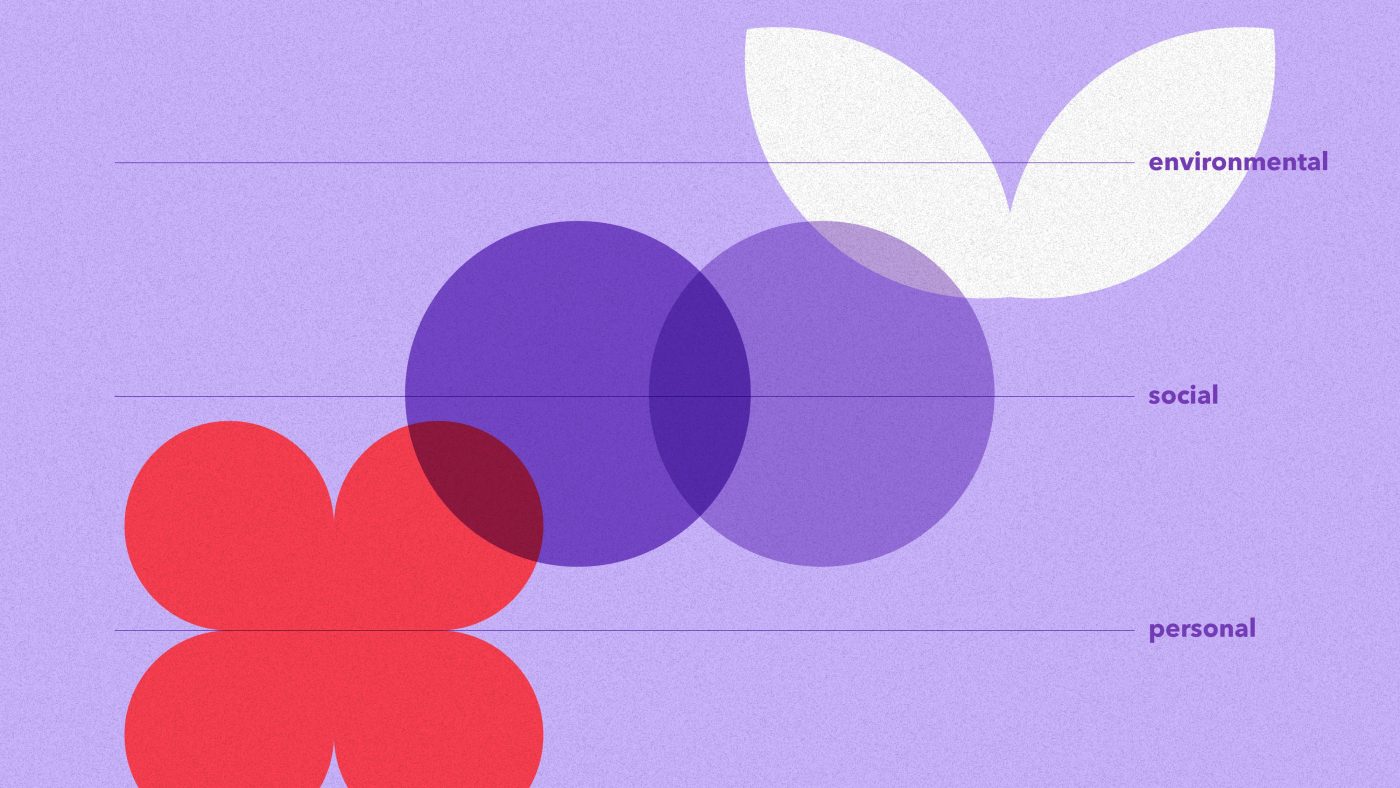
The techniques generated by this methodology are being increasingly used to develop user experience in digital products and services such as, for example, Carbon footprint applications, apps that monitor the carbon footprint, allowing people to see how their daily actions impact the environment. It is a design approach that has great potential as an amplifier of environmental awareness and can be used to transform the user’s sustainable intention into sustainable attitudes. There is an extensive agglomeration of personal, social and environmental factors that influence behavior. Most of them can be attributed to three levels:
Companies and brands with a sustainable purpose can play a leading role in these transformations, generating a product-as-a-service offer (product-service system) to meet user needs and generate value. It is also necessary to develop brand-users relationships, seeking to understand their motivations, consumption habits and information needs.
Below we list some examples of brands that take part in this movement:
Before having an idea for behavioral change, it is first necessary to fall in love with the problem, observing or interviewing individuals, trying to put yourself in their shoes. You will be surprised to note that a great deal of the thoughts and beliefs that each one holds are their own projected worldview, and not necessarily that of the target audience they wish to influence.
Lígia Dembinski, Design Manager & ESG Leader
Since August 2021, CBA B+G has been officially remote first. While many businesses are eager to resume face-to-face interactions, we believe that the future of successful organizations lies in adopting an essentially remote model and adapting to the digital processes inherent in this choice.
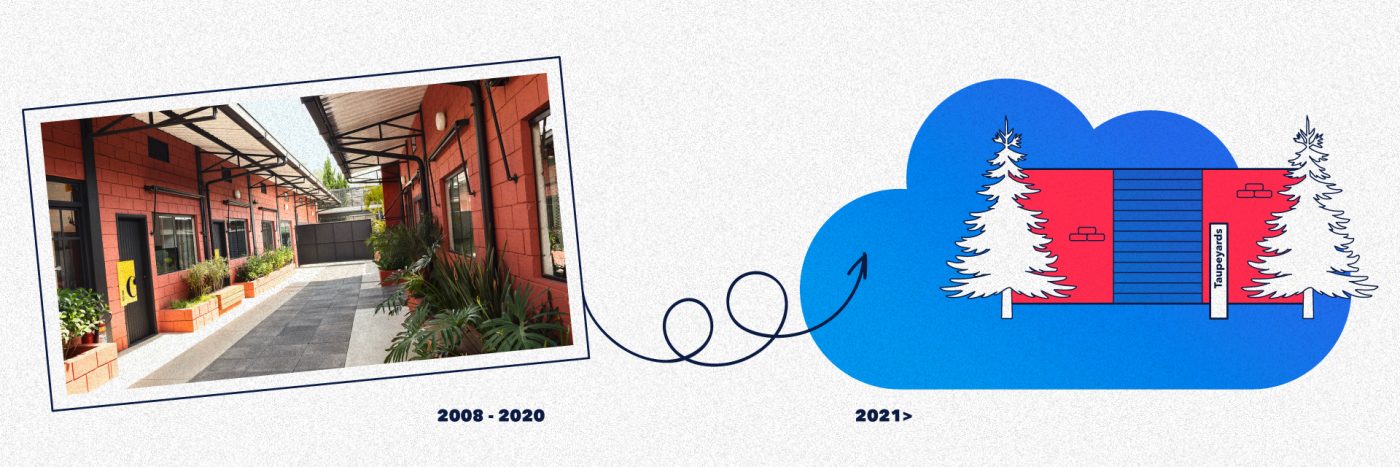
Since 2008, CBA B+G had been operating in a former warehouse on Rua Álvaro Rodrigues in the district of Brooklin, in São Paulo. The place perfectly matched us: it was an inviting space for teamwork, full of green areas and environments designed for collaboration, co-creation, and prototyping. We had created a very special environment over the years, that was loved and desired by everyone who had ever been there – employees, customers, or business partners.
In March 2020, the pandemic landed in Brazil. Like so many other companies, we had to adapt to the urgency of remote work to maintain the safety of each of the then-eighty employees. It wasn’t easy, we weren’t prepared. Almost nothing was in the cloud; we relied on a local server and heavy, immutable working tools. Many designers and production professionals had to take home their computers, mostly desktops, in a hurry. Chairs, ergonomic supports, monitors, and personal items had to be packed, and in addition to the logistic struggle, leaving our comfortable and beloved shed so abruptly felt as if a piece of our identity as CBA B+G had been ripped away.
We entered 2021 with many restrictions on social interaction, so we were forced to stick with the remote model. We noticed that companies of all sizes around the world were permanently adopting the hybrid or remote model. We realized it was a one-way path. Even after the end of the pandemic, the attitude toward work and productivity in organizations would never be the same. We chose the remote first model and said goodbye to the space we occupied, knowing that, of all the scenarios, the physical no longer had adherence to the new reality of work relationships, and the hybrid would be a potential combination of the worst of both worlds, preventing the cultural turn that we so desperately needed. It was not an easy decision, but I am confident that we made the right choice, a choice that contributed to ensuring the sustainability and success of our organization in the long term.
The remote first culture doesn’t happen overnight. It needs to be built. In a few months, we had to set up an office in the cloud, acquire new communication habits and tools in a remote work environment, learn remote project management skills, and build connection and trust without the help of a physical space. To put this into practice, it was necessary to review our metrics, behaviors, communication, and mindsets.
In addition to the structural challenges, we face an even greater cultural challenge. No matter how well a group of people works remotely, they miss getting together outside business meetings: bumping into each other in corridors, having coffee together, or celebrating birthdays. This is both natural and human. We recognize the importance of maintaining and nurturing this type of human connection, which is why we created our Get Together – in-person bonding events held every three months. Furthermore, by establishing a strong Culture and People department and improving the Communication department, we enhanced listening and increased the frequency and quality of content aimed at internal audiences. We also provide the benefit of a coworking network with over 1600 workspaces throughout Brazil to encourage meetings between teams that are in the same city.
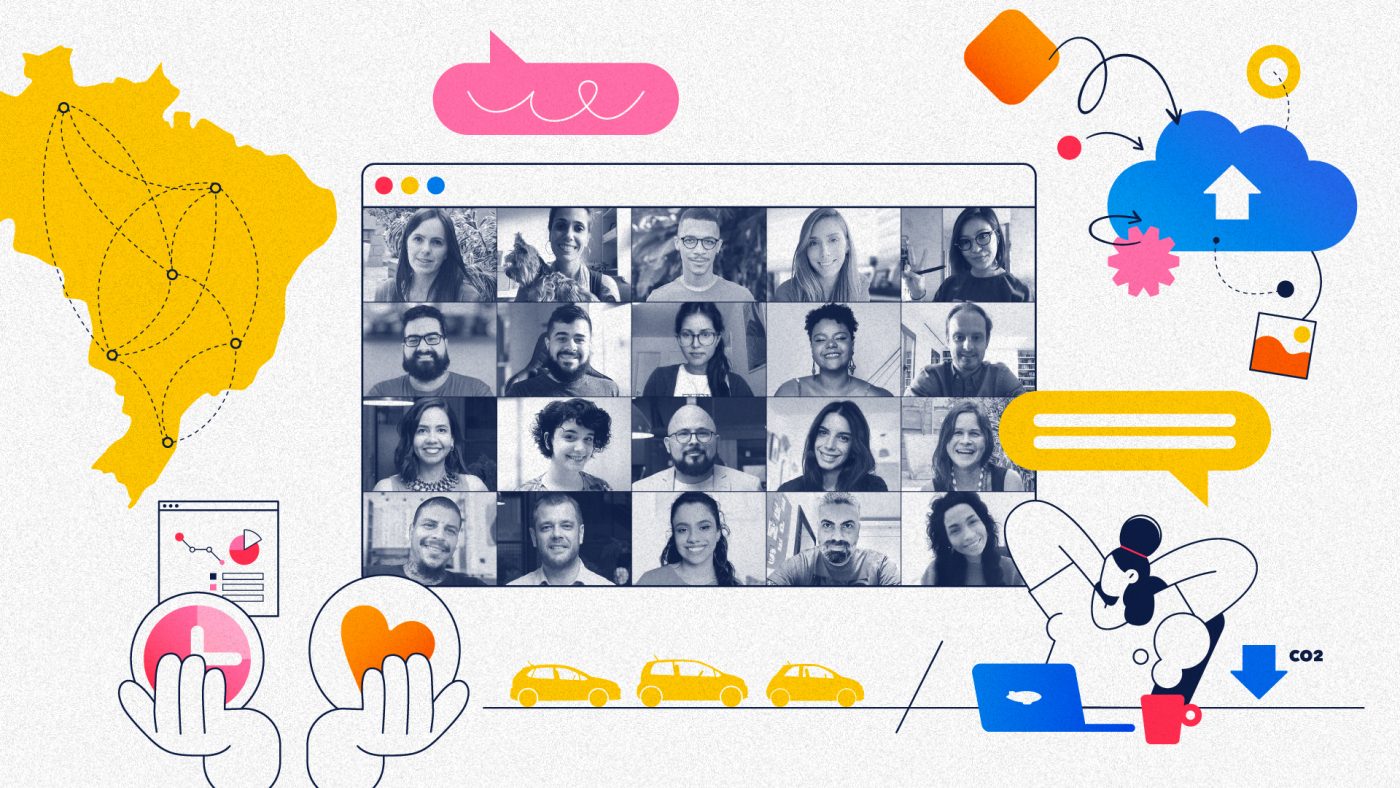
In a couple of years, our way of working evolved for the equivalent of a decade. Today, I see major positive changes:
I am proud and confident in our choice of business model. Today’s CBA B+G is more agile, diverse, and collaborative than ever before, and there is still enormous room for collective improvement ahead. Want to join us? Click here! Or if you would like to work with us on a project, come this way.
_
Luis Bartolomei
Business design is an operational style that combines business, strategic, and analytical approaches with the practices and mental model of design. It helps structure how each element of a business model affects the experience of customers and users.
In other words…
The discipline works at the intersection of feasibility, viability, and desirability to create innovation, helping companies and organizations move from point A to point B through a designed business model, or business model created based on the design approach.
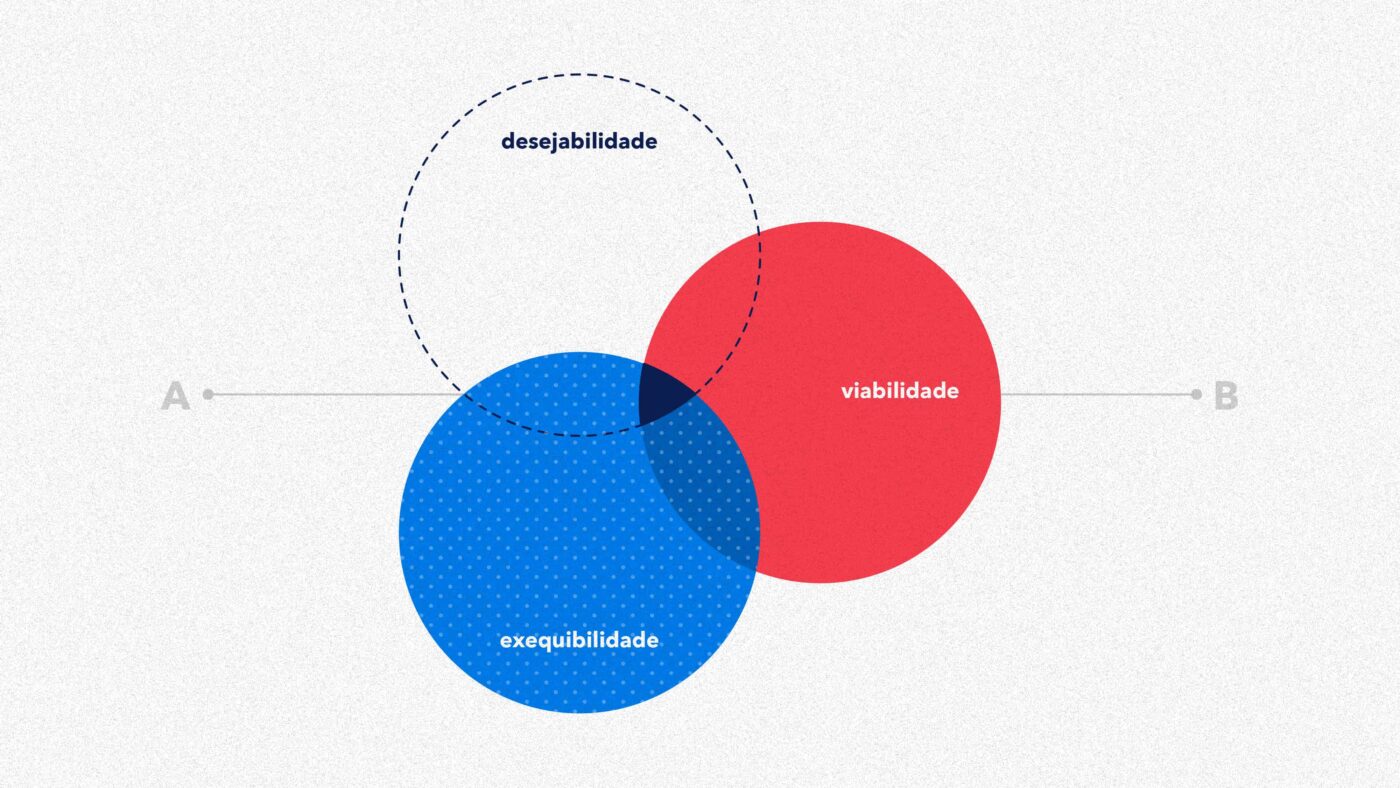
In the BANI (“B:rittle, A:nxious, N:on-linear and I:ncomprehensible”) world we live in, business design can be extremely valuable to a company. The growth of startups, rapidly shifting markets, and ever-evolving technological possibilities require the creation of innovative business models and the reassessment of conventional ones. Business design, among other things, provides the tools and methods to develop and test business models with a truly human-centered value proposition. But the discipline addresses many other issues. Here are some of its applications:
It is a strategy that can help brands and businesses overcome a variety of problems, but how does this relate to the design approach? How does a business designer act in the design process?
The three primary functions of a business designer during a design process are:
1. Use a business perspective to guide or inform the design process in order to make sure that the final product effectively addresses business issues.
2. Translate design solutions into value and impact using a language that business stakeholders are familiar with in order to prove that design provides solutions to business problems.
3. Use human-centered methodologies to strengthen the commercial and financial aspects of design work to produce services and products that are viable.
To understand what is meant by business design and the mindset of business designers, it is essential to keep in mind four major pillars: multidisciplinary approach, abductive reasoning, customer focus, and prototyping.
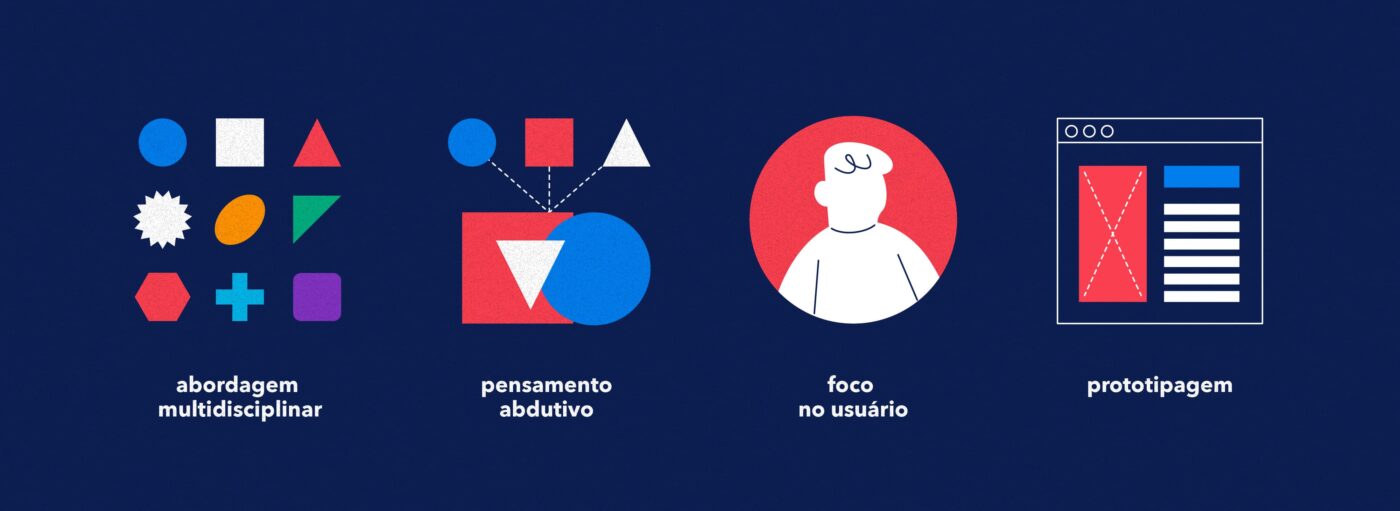
– Multidisciplinary approach
Design thinking emphasizes the value of assembling a diverse team, including the different stakeholders and users of the company’s product or service, to avoid having one viewpoint dominate the outcome. This combination enables us to examine the issue from various angles and ask the pertinent questions, such as: Is it desirable? Can we really do that? Does this make sense for my business?
– Abductive reasoning
Abductive reasoning derives from design thinking. Most business school programs teach deductive reasoning – from rules to conclusions – and inductive reasoning – from examples to rules. In clearly defined contexts, both deductive and inductive reasoning perform well. Working with businesses, however, frequently entails having access to insufficient information in a highly complex system. The concept of wicked problems, a term coined by Herbert Simon – a scientist and the inventor of design thinking, explains it: the more complex and multidimensional the problems, the more they demand a collaborative methodology and a deep understanding of human needs. Therefore, abductive thinking, a combination of inductive and deductive reasoning, is actually more suitable for such situations.
– Focus on the user
Business design uses user-centered and empathic design approaches. The starting point of any challenge is people. Every strategy is built based on a deep understanding of users, including information on their problems, objectives, and pain points. This helps us develop solutions that best fit their lifestyles.
– Prototyping
Business designers create prototypes not only to prove their validity but also to learn. To come up with the best-case scenario, we don’t simply consult a spreadsheet. We launch products and services to test the business. We develop financial projections and business cases to prove the financial viability of a product. We outline product ideas that represent strategic trade-offs to inform our strategic decisions. We create extreme business model scenarios and use them as prototypes to learn from customers, suppliers, and other stakeholders. We occasionally produce business pitches that help make new business ideas concrete so that organizations can support the development of spin-offs or fund a startup.
Business design is….
The discipline of business design is relatively new, the result of the growing pressure on design teams and design agencies to adapt their work to a business context. Today, it is part of CBA B+G’s worldview on design. From graphic to business design, we believe that design is first and foremost a way of thinking that uses methods and mental models to solve problems based on the consumer experience. We work beyond the surface of our clients’ businesses, fully meeting their needs through projects that include branding, service design, marketing, and business modeling.
If you want to know more about the subject or if you are interested in working with us on a project, do not hesitate to contact us.
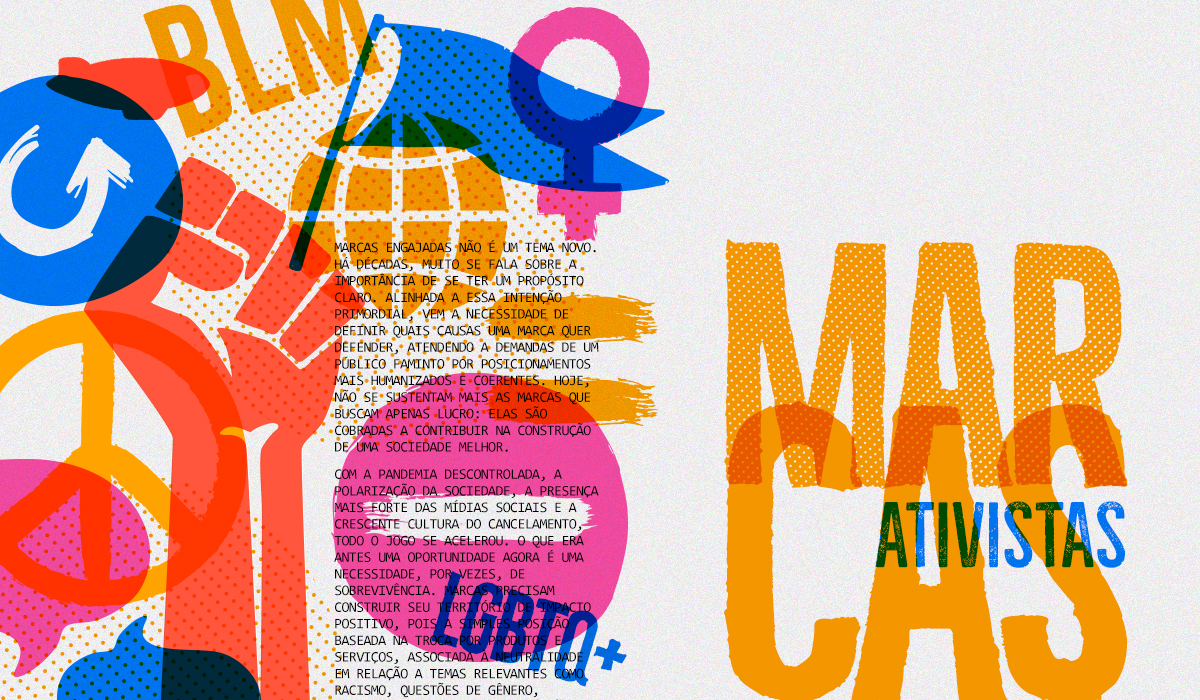
Brand activism is nothing new. The importance of having a clear purpose has been extensely discussed for decades. Aligned with this foremost intention comes the necessity to define which causes a brand wants to support, meeting the demands of an audience that craves for more humane and coherent stances. Nowadays, brands have to stand for more than just profit: they are expected to contribute to building a better society.
The uncontrolled pandemic, the polarization of society, the stronger presence of social media and the growing cancel culture have boosted the game. What used to be an opportunity, is now a requirement – at times, essential for the survival. Brands have to build a positive impact territory; the mere position of trading goods and services, coupled with the neutrality towards relevant issues such as racism, gender, feminism and environment, is no longer a strong enough offer. Not taking a stand may give rise to the impression of consent, while stating an opinion can be seen as hypocrisy – if the talk is not followed by concrete actions, aligned with the brand’s DNA – depleting the brand’s value.
Thus, brands must take a clear stance and genuinely commit to one or more causes to remain competitive. The challenge faced is how to approach it constructively, being faithful to the brand’s values and not sounding self-serving, besides being careful to minimize the risks of boycott in an increasingly demanding environment where one slip can be fatal.
Bearing this challenging and intriguing setting in mind, we propose some reflections to help brands understand the different possible types and levels of activism, the risks and benefits of speaking up. Paths that, when followed with truth and transparency, can lead to a real and long-lasting commitment.
We all know, there is no single way to engage, and there is no right or wrong. We suggest below an ‘activism profile classification’ based on the brand’s DNA and its intended relation with its stakeholders, more than on the company’s size or category. Here they are:
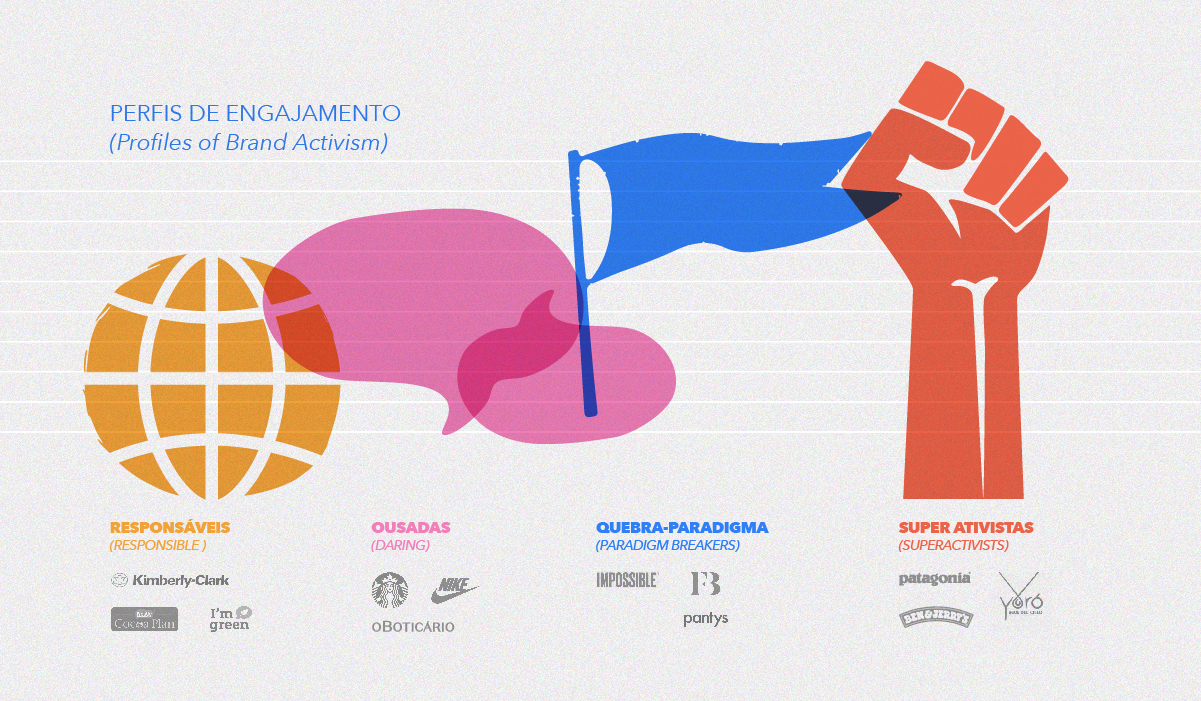
Superactivists
Brands that are activists since foundation, deeply engaged with causes related to the brand’s core values, and supported by the founding partners or CEOs themselves. They believe that action speaks louder than words, and they take to the streets with its public to be heard and actually aim to achieve social change. They create a strong emotional tie with its fans, so much that they usually become brand ambassadors.
Paradigm-breakers
Innovative brands, pioneers in their respective businesses since foundation. Their own core products or services are their flags, since their proposal is to change patterns and break a category status quo. They usually forge an emotional bond with their consumer base, for meeting previously unmet needs.
So, when is it worth to engage and get political about a current cause or issue? For Carolina Barruffini, CBA B+G Branding director, brands have to be more daring: “No doubt there are some risks involved when brands engage in relevant causes. However, many real examples have showed us that taking action is better than not taking a stand, even if there’s little impact – provided that the action is driven by truth and transparency.”
We listed below the pros and cons that every brand must consider before taking a stand.
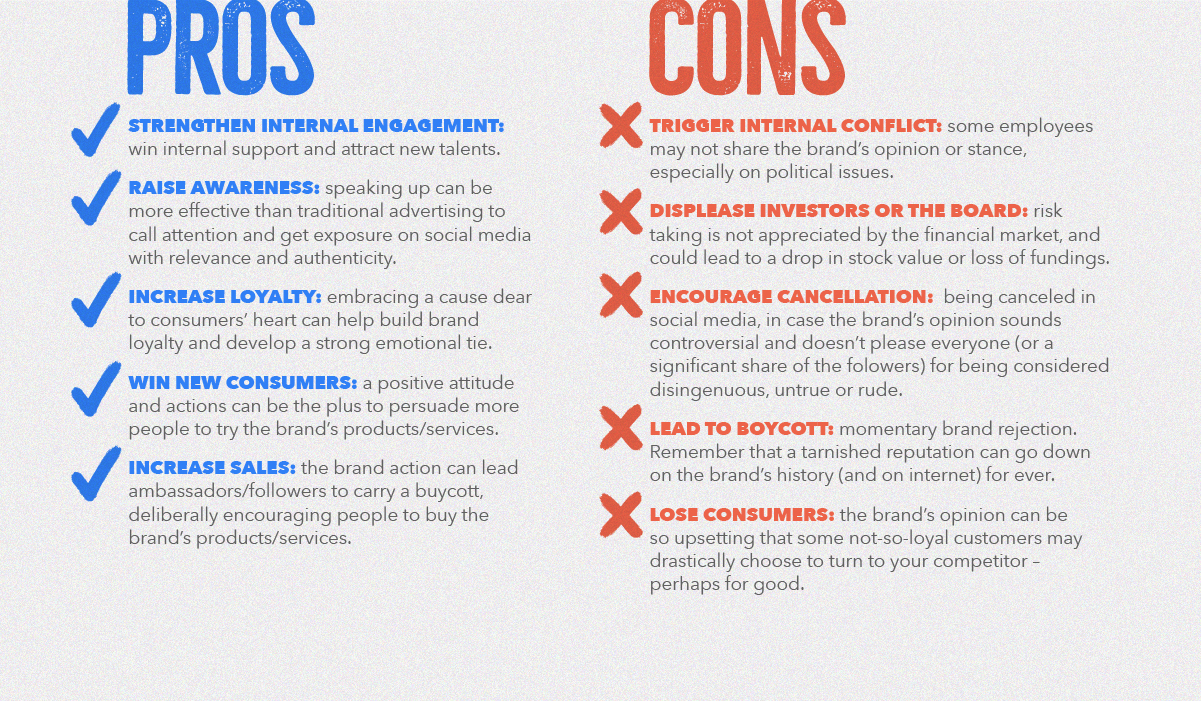
How then, can brand activism be a long-term, authentic and minimal-risk commitment? We suggest 8 steps to make it happen. It is a long journey, however it can surely put you on the right track to remain relevant in the future.
The 8 steps for achieving Positive Impact are:
1. Define a clear and powerful brand positioning
What is the brand reason for being, its beliefs? What is the brand’s DNA, its personality, its target audience? Branding for the future – a playbook with thoughts on how to reconnect brands, consumer and market – the three fundamental business spheres (which are still more importante in times of pandemic) – is a way to help you understand the brand context and its actions. Learn more about it here.
2. Choose your battles
Based on the brand core values – and aligned with them –identify the causes that the brand has credibility to support.
3. Define the stakeholders
Besides the target audience and brand consumers, who else does the brand impact, directly or indirectly, externally or internally? Stakeholders include employees and their family, board and investors, influencers, specialized media, government and social agents.
4. Look at the brand’s track record (and its present moment)
Although the brand purpose may have evolved over the years, the brand’s past cannot be ignored. It’s important to revisit previous actions, statements and campaigns to assess the credibility of engaging on a topic. And, sometimes, make a mea culpa (Skol has done this in 2017, who remembers?). Also, reputation must be considered; if it is fragile, spotlighting your brand may not be the best move.
5. Define the brand activism profile
Among the different profiles – superactivist, paradigm breaker, daring, responsible – which makes more sense for your brand today and which it aspires for the future?
6. Identify potential risks
The more renowned the brand is, the more important it is to assess the risks and benefits of taking a stance – or of staying neutral.
7. Walk the talk
Promises, great speeches or fierce campaigns are not enough to guarantee a brand’s survival without significant and real actions to support them. Consumers expect the brand (company) to engage in a realistic and tangible way, and if it doesn’t, they will ask for it.
8. Listen to feedback
Stakeholders feedback deserve attention. The brand must learn from its mistakes and successes and act quickly. Monitoring the brand’s “promises versus deliveries” can be decisive for the brand’s health and reputation.
Would you like to delve deeper into the topics of activism, brands and branding? We recommend: watching the interview with Rose Marcaria – Patagonia President and CEO – for Stanford students; listening to the episode Ativismo nos dias atuais (Today’s activism), from the podcast “O Tempo Virou” by Giovanna Nader, with the social activist Alessandra Orofino; and last but not least, reading this excellent article on the importance of taking risks, written by brand strategist Jasmine Bina.
You can always get in touch with us if you wanna chat about the challenges and opportunities for your brand. And if this subject inspires you and you are or know business professionals, strategists and designers who are interested in being part of our team, send an e-mail to [email protected] with expectations, goals and stories. We are always looking for new talents!
The content of this article had the contribution of: Carmen Beer, Ana Cerqueira, Giuliana Sanchez, Thaísa Miyahara, Carolina Barrufini, Ana Biselli, Renato Storni, José F. Ramirez, Fabiana Quiroga, Josy Lamenza, Daniela Irrazabal, and Luis Bartolomei.
The metaverse is undoubtedly one of the hot topics of the moment, especially for the marketing and communication sectors. More and more businesses, especially the big ones, are investing time, money and energy in building their metaverse presence. Every company wants to establish itself in this new digital world – from tech to fashion, from food to mobility, no matter the field. In their eyes, the metaverse is either the internet’s future or a dreamy alternative to reality (or both).
Our first step was to look into what, in essence, the metaverse is. The first important information we gathered is that currently, there is no single metaverse but several, each with its characteristics. Decentraland, for example, is a space mainly geared towards entertainment; Bloktopia, self-defined as the “home of crypto”, features informative and educational materials on cryptocurrencies. The Sandbox is the home of the most exclusive events in the metaverse, while Horizon Worlds – developed by Meta, the celebrated evolution of Facebook – provides experiences and services for businesses. Finally, Roblox is the explosive new gaming frontier, where the new generations can gather to create new video games.
After taking a deep dive into the main metaverses and their various definitions, we have found our own semantic and functional description for it:
The metaverse is an undefined, independent and interactive virtual space.
It is undefined in that the users alone define it; their only limit is their own creativity. It is independent because it would continue to exist persistently and decentralised, even without any active users. Lastly, it is interactive because of its substantial social component: user interaction goes beyond replicating everyday life, even evolving it.
Now we know what the metaverse is and what its principal incarnations are. But one thing remains unclear: why was it created? Why is the metaverse growing, commanding so much interest and attracting crowds of people?
The answer, as suggested earlier, lies in people’s needs. This new digital universe is developing in response to specific drivers and necessities that have recently become most prominent.
First is the issue of accessibility; the metaverse is a universe without walls and barriers, allowing everyone to express themselves freely. People – especially Gen Z – increasingly stress the importance of this aspect, which is of great value to them.
This instance is in line with their desire for active participation in the life of brands: today, we are moving beyond the traditional concept of branding, creating communities, and users want to belong.
This feeling of belonging to a community introduces a further need: aggregation. Thanks partly to new technologies, human connections have become increasingly important in a world disrupted by a pandemic and social distancing. New technologies, in particular, have evolved to respond to an ever-increasing need for collaboration due to social distancing. Digital socialisation and technology-enabled peer-to-peer support are helping Gen Z meet their desires. They want to feel empowered in enhancing and building their education and careers, bypassing conventional processes typical of the labour market.This generation also seeks a higher level of interaction with their reference brands, which they view as a beacon in their daily lives online and offline. And it is precisely for this reason that the standards of the buying experience are changing and evolving, becoming increasingly decisive for brands’ success.
What drives purchases in this new context? Uniqueness. With the advent and widespread adoption of NFT and blockchain, people increasingly value uniqueness in objects they own, whether physical or digital.
Once we have defined the metaverse and the reasons for its growth, we need to understand how the brands already present within are trying to respond to people’s needs. Noticing a correlation between needing and acting, we will here examine significant case studies of brands already working within this process:
Accessibility: Nike has recreated its HQs within Roblox’s 3D immersive space, enhancing the brand’s mission to turn sport and play into a lifestyle. Inside Nikeland, you can play different sports, create personal challenges, and dress your avatar with dedicated Nike products.
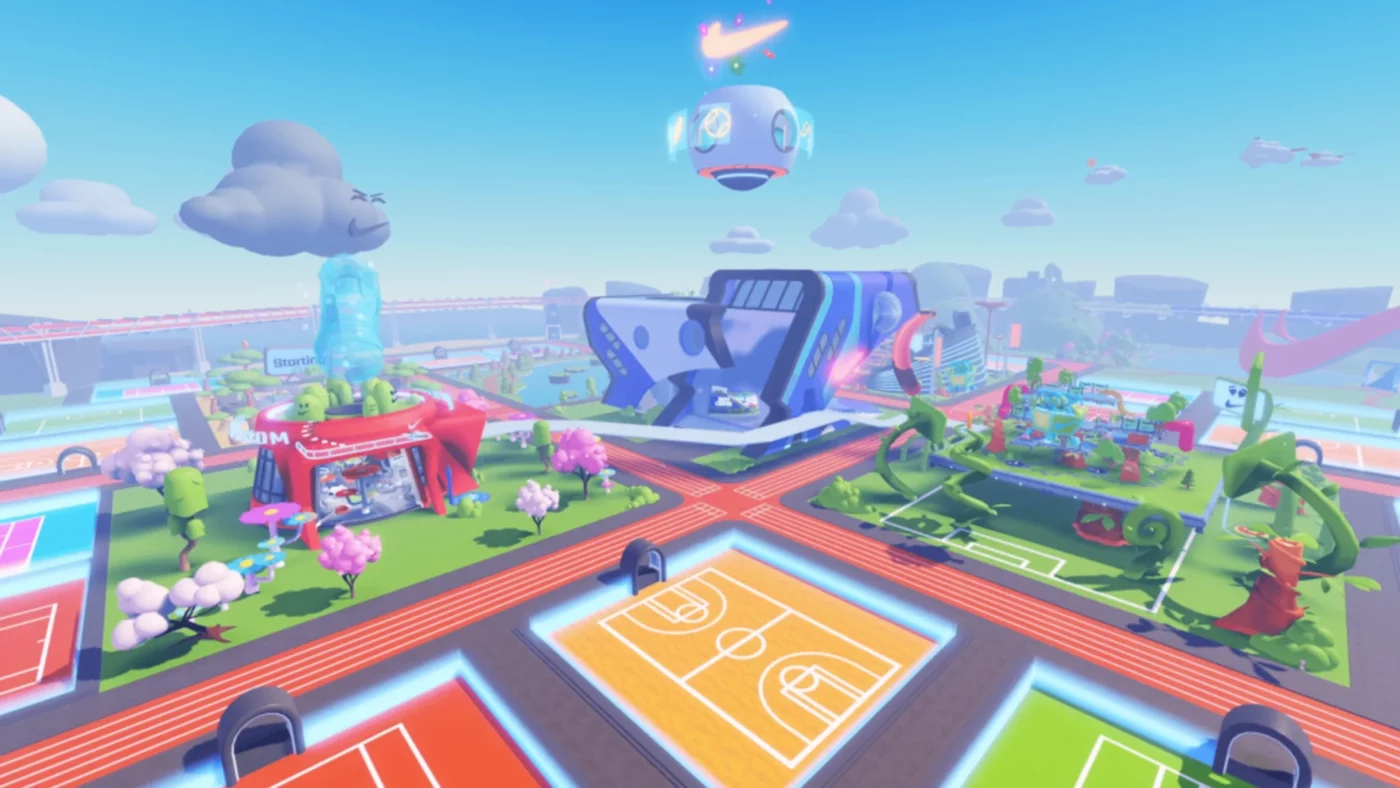
Participation: Socios.com is a fan tokens platform that cooperates with leading European football clubs. By purchasing tokens, users can directly influence team decisions and win and participate in exclusive experiences, all through the app, feeling even more part of their club.
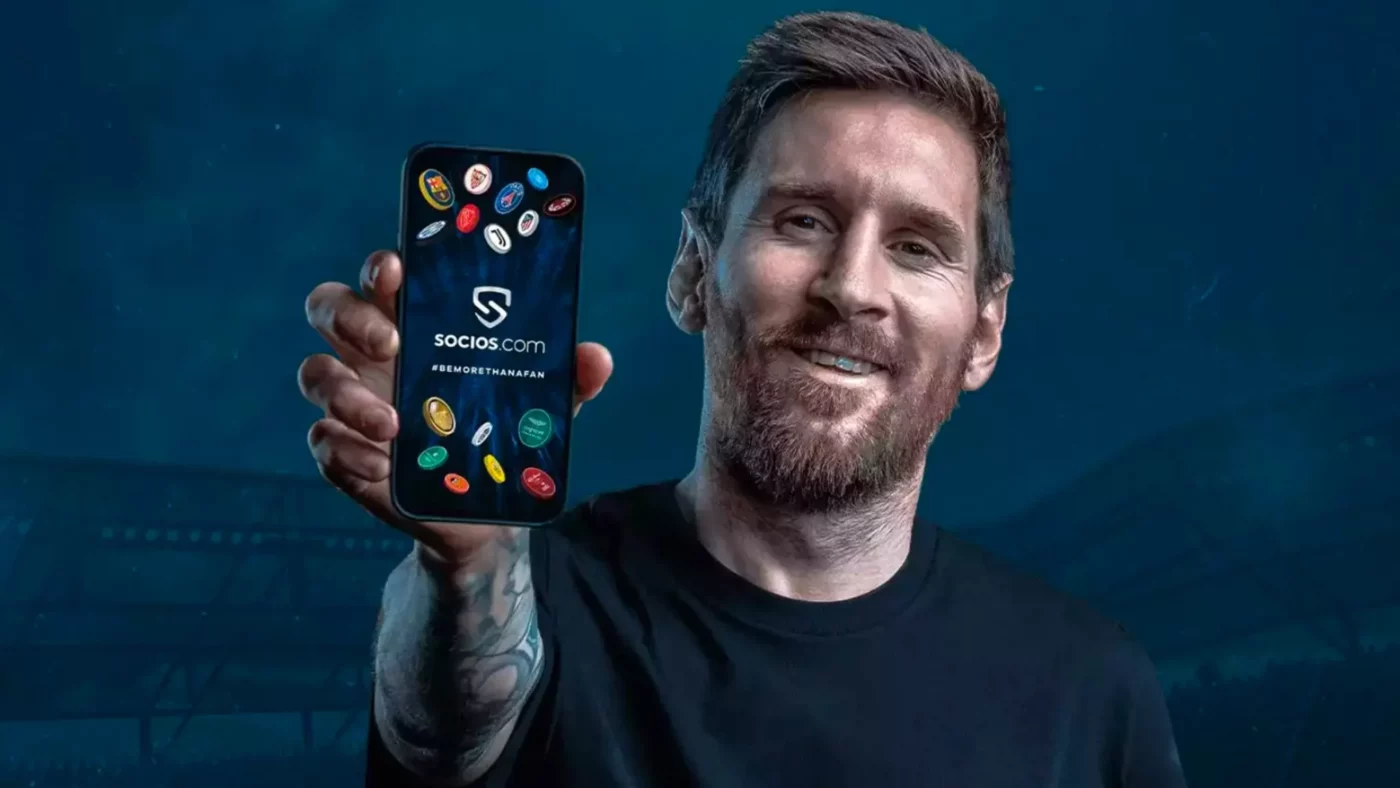
Aggregation: In partnership with Coca-Cola, Rock In Rio invaded the Metaverse with RockinVerse. Fans were able to watch streamer Casimiro reacting on his Twitch channel to the 12 spaces created by Rock in Rio inside an island in Fortnite, and also engage in various challenges that the attractions present.

Collaboration: Meta’s Horizon Workrooms is a collaborative tool for people to come together and work in the same virtual room, regardless of physical distance. It works in virtual reality and on the web, enhancing a team’s ability to collaborate, communicate and connect remotely through the power of Virtual Reality.
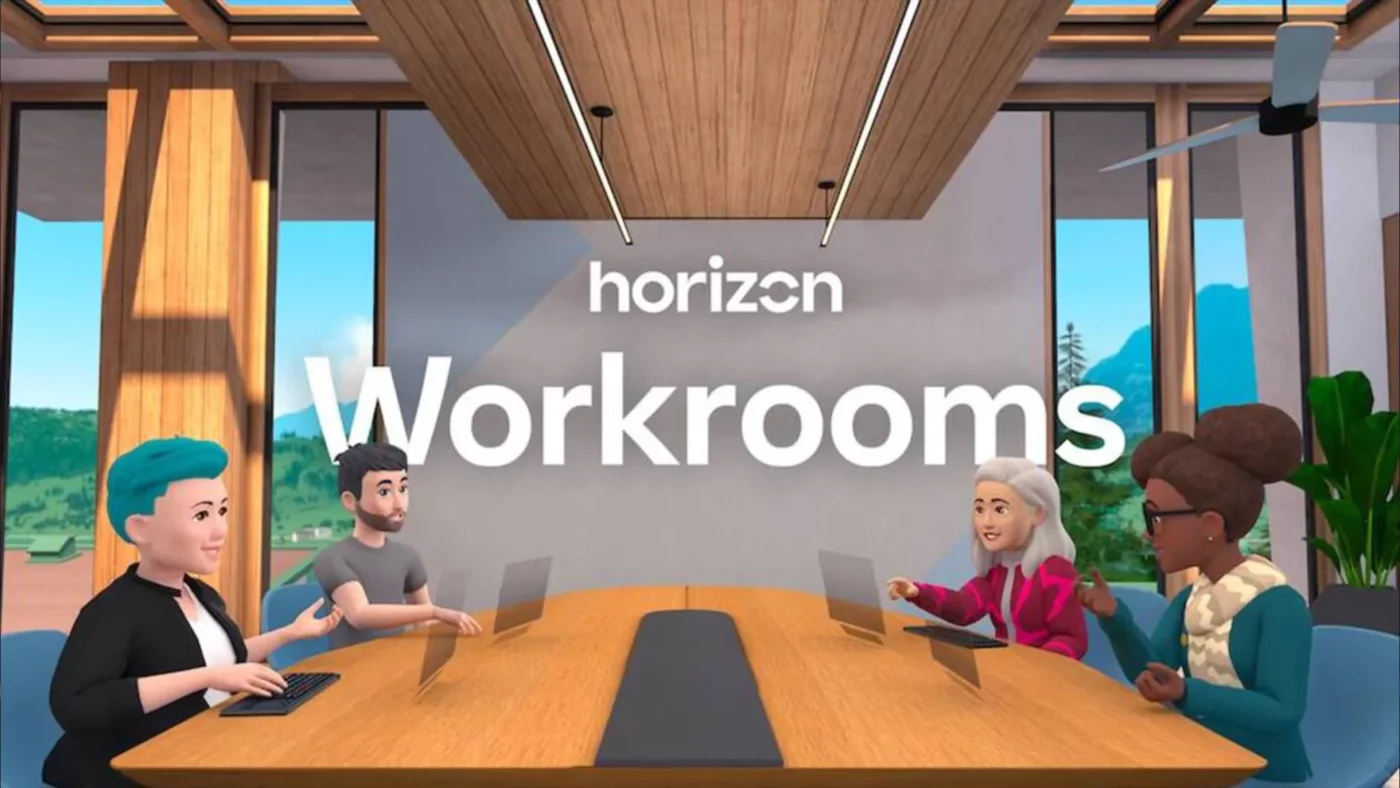
Empowerment: GucciXFACEIT Last year, Gucci announced its collaboration with FACEIT, an E-Sports tournaments organiser. Together they aim to create a gaming academy, providing players with all the tools they need to become professional gamers and develop their skills.
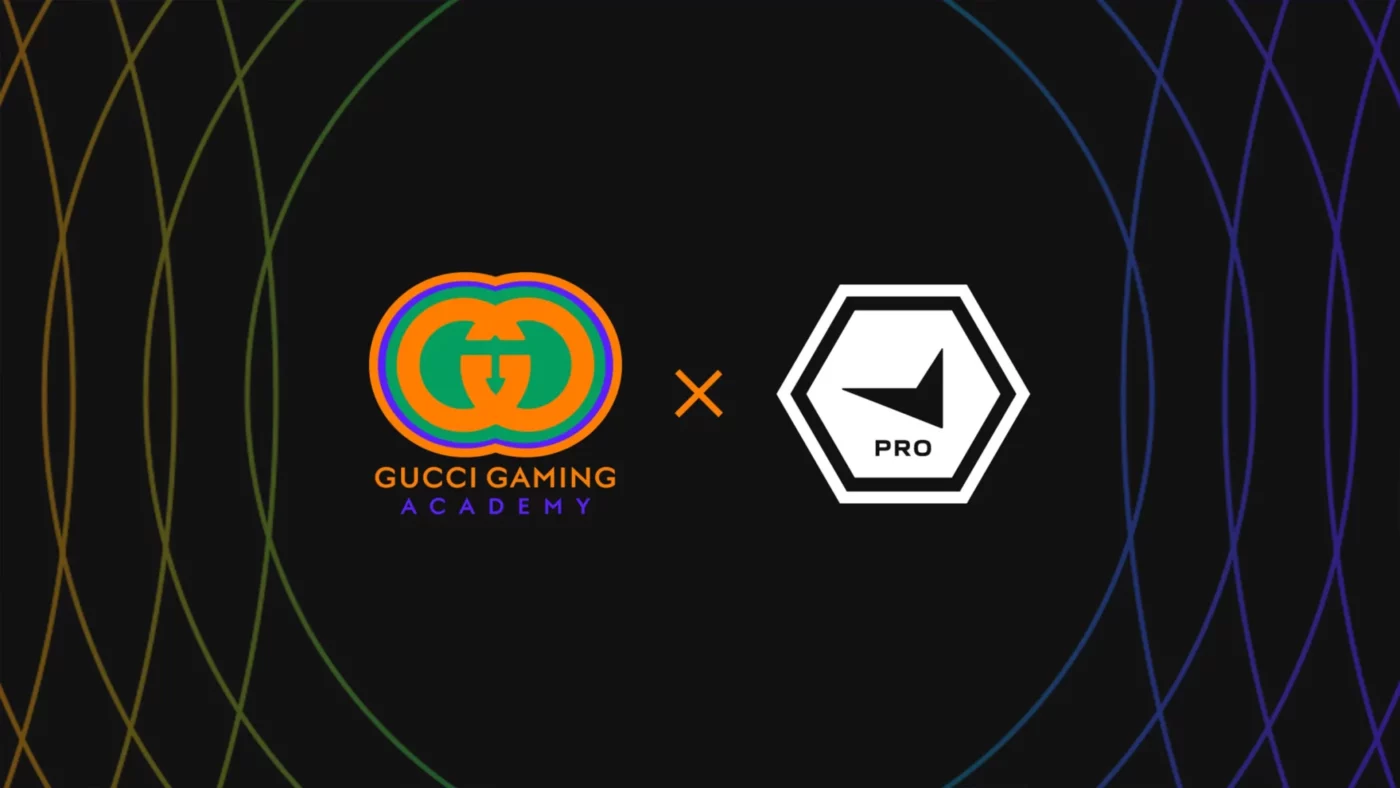
Interaction: The Brazilian Football Confederation (CBF) debuted in Garena’s Blockman Go Metaverse. The organization launched the Arena Seleção, a space that brings together interactive activities, museum, area for photos and games for users. The goal is to get closer to young fans of the Brazilian national soccer team through the digital world and games, a market that CBF aims to invest more in.

Shopping experience: Satiko, virtual influencer of Sabrina Sato, opened an activation space in Metaverse: Peixe ao Cubo, a restaurant of which she is a partner in the real world, enters the virtual reality of Cidade Alta, in GTA. The space, in addition to serving virtual meals, is a place where brands can run activations and interact with regulars.

Uniqueness:Italia Regina launched its Eatable Tokens on OpenSea. These thematic NFTs focus on the most iconic Italian food products: tokens translate to unique vouchers of an equal amount to spend on “www.italiaregina.it”, uniting tasty food and the digital world.

If you are wondering how your brand could position itself within the metaverse and how to create a closer relationship with its users, email us.
© CBA B+G 2023
Privacy Overview